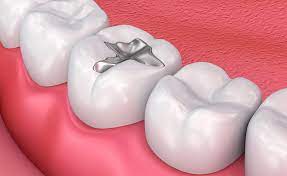Dental fillings are a common restorative procedure for treating cavities and restoring damaged teeth. Over the years, dental technology has advanced, providing various dental fillings to cater to individual needs and preferences. This comprehensive guide will explore the different types of dental fillings available today and their unique characteristics, advantages, and considerations. Whether you’re facing a cavity or considering replacing an old filling, understanding these options will help you make an informed decision about your oral health.
Amalgam Fillings
Amalgam silver fillings have been used in dentistry for over a century. They are composed of metals, including silver, tin, copper, and mercury. Amalgam fillings are strong, durable, and cost-effective, making them popular for treating cavities in molars and premolars. However, they have a silver appearance, which can be less aesthetically pleasing for visible teeth.
Composite Fillings
Composite fillings are a tooth-colored option that has gained popularity due to their aesthetic appeal. They are made of a blend of plastic and glass particles, which can be matched to the natural color of your teeth. Composite fillings are an excellent choice for visible teeth or areas where aesthetics are a concern. They bond well to the tooth structure, providing additional support and versatility.
Ceramic Fillings (Inlays and Onlays)
Ceramic fillings, also known as porcelain fillings, are custom-made in dental laboratories to precisely fit the cavity or damaged area of the tooth. They offer superior aesthetics as they can match the natural tooth color. Ceramic fillings are strong, resistant to staining, and provide an excellent long-term solution for restoring teeth with moderate to severe damage. Inlays are used when the cavity is within the tooth’s cusps, while onlays are used when the damage extends to the chewing surface.
Glass Ionomer Fillings
Glass ionomer fillings are made of a blend of acrylic and glass materials. They release fluoride, which can help prevent further decay in the tooth. These fillings are often used for baby teeth, non-load-bearing areas, and in combination with other restorative materials. While not as durable as amalgam or composite fillings, they offer certain benefits, especially in specific dental situations.
Gold Fillings
Gold fillings, also known as inlays or onlays, are made of gold alloy and are custom-made to fit the cavity precisely. Gold fillings are well-tolerated by gum tissues and can last decades with proper care. They are highly durable and provide an excellent option for restorations in the back teeth, where strength is crucial. However, gold fillings are more expensive than other filling materials and appear distinct.
Cast Gold Fillings
Cast gold fillings, also called gold inlays or onlays, are similar to gold fillings but are created in a dental laboratory based on impressions taken by your dentist. They offer a precise fit and are extremely durable. Cast gold fillings can withstand heavy biting forces and are an ideal choice for molars and premolars. However, like gold fillings, they are more expensive than other options.
Considerations
When selecting the right type of dental filling, several factors should be considered:
Location Of The Cavity
The location of the cavity within the mouth may influence the choice of filling material. Tooth-colored options like composite or ceramic fillings are often preferred for visible teeth.
Aesthetics
If aesthetics are a primary concern, tooth-colored fillings like composite or ceramic are the best choice.
Durability And Strength
For teeth with significant biting forces, amalgam, gold, or ceramic fillings may be more appropriate due to their strength and durability.
Allergies Or Sensitivities
Some individuals may have allergies or sensitivities to certain filling materials, so discussing this with your dentist is essential.
The Bottom Line
Choosing the right type of dental filling is crucial for maintaining your oral health and ensuring the longevity of your dental restoration. There’s a suitable choice for everyone’s unique dental needs and preferences with various options available, including amalgam, composite, ceramic, and gold fillings. Consult with your dentist to determine the best filling material for your specific situation, and take pride in preserving your healthy smile for years to come.

